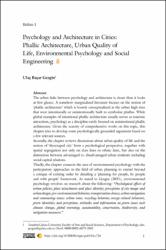| dc.contributor.author | Gezgin, Ulaş Başar | |
| dc.date.accessioned | 2023-07-11T12:14:07Z | |
| dc.date.available | 2023-07-11T12:14:07Z | |
| dc.date.issued | 2023 | en_US |
| dc.identifier.citation | Gezgin, U. B. (2023). Psychology and Architecture in Cities: Phallic Architecture, Urban Quality of Life, Environmental Psychology and Social Engineering . In: Akarslan Kodaloğlu, F. (ed.), Research on Art and Design. Özgür Publications. DOI: https://doi.org/10.58830/ozgur.pub134.c724 | en_US |
| dc.identifier.isbn | 9789754476453 | |
| dc.identifier.uri | https://hdl.handle.net/20.500.12941/141 | |
| dc.description.abstract | The urban links between psychology and architecture is closer than it looks at first glance: A somehow marginalized literature focuses on the notion of ‘phallic architecture’ which is loosely conceptualized as the urban high rises that were intentionally or unintentionally built to symbolize phallus. While global examples of intentional phallic architecture usually serves as touristic attractions, psychology as a discipline rarely focused on unintentional phallic architecture. Given the scarcity of comprehensive works on this topic, this chapter tries to develop some psychologically-grounded arguments based on a few relevant sources.
Secondly, the chapter reviews discussions about urban quality of life and the notion of ‘skyscraped city’ from a psychological perspective, together with spatial segregation not only on class lines or ethnic lines, but also on the distinction between advantaged vs. disadvantaged urban residents including social capital relations.
Thirdly, the chapter connects the area of environmental psychology with the participatory approaches in the field of urban planning to extend beyond a critique of existing order by detailing a ‘planning for people, by people and with people’ framework. As stated in Gezgin (2011), environmental psychology revolves on research about the following: “Psychological effects of urban policies; place attachment and place identity; perceptions of city image and urban design; pro-environmental behavior, transportation choices, urban navigation and commuting issues; urban noise, recycling behavior, energy-related behaviors, green identities; and perceptions, attitudes and information on green issues such climate change, global warming, sustainability, conservation, biodiversity, and mitigation measures.”
Finally, as the backdrop to all these topics covered in the chapter, the debates on social engineering are on the spot, since the chapter conceptualizes psychology and architecture as two subareas of social engineering, following a holistic analysis of ‘authority’. The chapter plans to reverse-engineer psychology and architecture in this context. | en_US |
| dc.language.iso | eng | en_US |
| dc.publisher | Özgür Yayınları | en_US |
| dc.relation.isversionof | 10.58830/ozgur.pub134.c724 | en_US |
| dc.rights | info:eu-repo/semantics/openAccess | en_US |
| dc.subject | Architecture | en_US |
| dc.subject | Psychology | en_US |
| dc.subject | Environmental psychology | en_US |
| dc.subject | Participatory planning | en_US |
| dc.subject | Social engineering | en_US |
| dc.title | Psychology and architecture in cities : phallic architecture, urban quality of life, environmental psychology and social engineering | en_US |
| dc.type | bookPart | en_US |
| dc.authorid | Ulaş Başar Gezgin / 0000-0002-6075-3501 | en_US |
| dc.department | Fakülteler, Sanat ve Sosyal Bilimler Fakültesi, Psikoloji Bölümü | en_US |
| dc.contributor.institutionauthor | Gezgin, Ulaş Başar | |
| dc.identifier.startpage | 1 | |
| dc.identifier.startpage | 16 | |
| dc.relation.journal | Research on Art and Design | en_US |
| dc.relation.publicationcategory | Kitap Bölümü - Uluslararası | en_US |

















